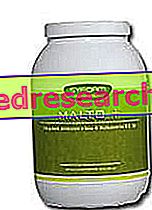
Information on Malt + Syform
Malt + Syform
Food supplement based on Maltodextrin
FORMAT
Pack of 900 grams
FOR DAILY DOSE
Energy value 228 Kcal
Proteins 0 gr
Carbohydrates 57 gr of which
Dextrose 0.4 gr
Maltose 1.60 gr
Trisaccharides 2.38 gr
Tetrasaccharides 2 gr
Polysaccharides 47.88 gr
Fats 0 gr
Maltodextrin - macromolecules of different molecular weight obtained following controlled enzymatic digestion of corn starch, rice or potatoes. The different modes of hydrolysis lead to the formation of polysaccharides with chemical-physical properties and different digestion and absorption times. The parameter that contains these characteristics is called Dextrose Equivalence, and can be understood as the ease with which maltodextrins release glucose molecules.
Fixed to 100 the dextrose equivalences of pure glucose (monosaccharide), we recognize:
- Low DE maltodextrins: they are characterized by reduced solubility in aqueous environment and by a high molecular complexity, which guarantees a gradual and prolonged release of the glucose molecules that constitute them;
- High DE maltodextrins: they are easily soluble in aqueous environment and structurally simple, guaranteeing a rapid release of glucose and a rapid and intense energy charge.
Taking into account the structural and digestive characteristics of these polysaccharides, it is clear that it will be possible to choose the maltodextrins that are best suited to athletic performance or the goals set.
- High dextrose equivalence maltodextrins may be useful in final sprints or in explosive strength sports, representing a valid percompetitive ration or a snack immediately before the race. Furthermore, they can be effectively used in stimulating the post-work-out production of insulin, thus supporting the post workout anabolic window.
- Maltodextrins with low dextrose equivalence guarantee a gradual release of glucose and energy; they can therefore be used as a waiting ration, before the race, saturating the reserves of muscle glycogen without risking potentially dangerous glycemic and insulinematic leaps. They adapt perfectly to endurance sports, where they represent a meal that is easy to digest and energetically valid, both before and during athletic performance.
Maltodextrins and food carbohydrates
One of the most frequent questions is why they prefer maltodextrin supplements to carbohydrates easily available in common foods. In reality the answer, however simple it may seem, must take into account the physical and nutritional needs of the athlete.
- In the pre-race snack : the athlete, in this phase, must be able to make a meal that can recharge the muscle glycogen reserves to the maximum, without taking too much time and energy for digestion, and avoiding insulin spikes and subsequent reactive hypoglycemia. Maltodextrins are therefore helpful because they require significantly less time and energy expenditure than digestion foods, maintaining a more controlled glycemic profile over time.
- During the performance : the sportsman must be able to energetically replenish the organism in a rapid, undemanding way from the digestive point of view and that avoids glycemic swings. In this case the liquid or gel form of maltodextrin represents a valid alternative to any solid snacks or softened drinks with sugar, guaranteeing rapid digestion and a constant and gradual energy intake.
- After the performance : the athlete must be able to restore the depleted glycogen reserves and possibly stimulate the anabolic phase. In the latter case the aforementioned advantages tend to be reduced, since it would be possible to program post work-out snacks that can easily meet the objectives of the sportsman, without resorting to supplements.
Rationale - Malto + Syform
In light of the aforementioned, and considering the various works proposed by the scientific world, it is possible to deduce how potentially effective is the integration with carbohydrates and maltodextrins. Optimal results are obtained in terms of energy strengthening, performance improvement, anti-catabolic effect, post-work-out anabolic effect and motivational effect. In order for these results to be realized, it is however necessary to develop rational and tested integrative protocols. Indeed, scientific literature and daily experience show:
- absence of ergogenic effect in the case of pregara integration, in a well-nourished organism that has previously consumed a carbohydrate-based snack;
- decrease in cognitive and muscular capacity (consequences of reactive hypoglycemia), following poorly made supplementation with high dextrose equivalence maltodextrin;
- Profuse diarrhea and dehydration due to incorrect preparation of drinks;
- Increased fat mass following abuse of these supplements.
Product features Malto + Syform
Unlike most of the maltodextrin-based products (DE 19/20), this supplement has low-equivalence dextrose maltodesrine (DE 10), which results in a more gradual and prolonged release of energy, perfectly adapting to the sports of endurance.
Recommended use by the company - Malto + Syform
We recommend taking 60 g per day (equal to 3 level measuring spoons) dissolved in 500 ml of water or other liquid.
Use in sports - Malto + Syform
Defining a standard and effective quantity of maltodextrin is almost impossible, as this must take into account the athlete's diet, his nutritional status, the type of training or performance to be performed, the goal sought, etc., etc.
From the rereading of the scientific works and from the general case studies, it seems that 30 grams of maltodextrin may be necessary to sustain an hour of physical activity at good intensity, while it seems that 1 gr of carbohydrates per kg of body mass is useful to restore stocks of glycogen in the post-work out.
The preparation of beverages must maintain concentrations of maltodextrin between 6% and 10%, in order to improve their absorption and avoid intestinal problems.
Synergies
Maltodextrin + proteins: in the recovery phase, it could be useful in improving the anabolic window.
Maltodextrin + mineral salts: fundamental for the reintegration of salt water, if formulated in a hypo and isotonic drink.
Maltodextrin + arginine: it strongly enhances glycogen synthesis compared to maltodextrins only;
Maltodextrin + fructose: improves muscle oxidation of ingested carbohydrates compared to the administration of maltodextrin alone;
Maltodextrin + amino acids: before training, it significantly reduces muscle damage, supporting performance and reducing plasma levels of cratinkinase.
Maltodextrin + antioxidants: they can reduce the oxidative damage induced by intense physical exercise.
Side effects Malt + Syform
The side effects that may occur following the incorrect administration of maltodextrins can be short or long term.
In the short term, problems can usually occur in the gastrointestinal tract, with abdominal cramps, diarrhea, nausea and vomiting.
The long-term effects, on the other hand, could be compared to those obtainable with excessive nutrition, rich in simple carbohydrates (overweight, obesity and related pathologies).
Precautions for use Malt + Syform
The product is contraindicated in cases of renal or hepatic disease, cardiovascular disease and / or hypertension, during pregnancy, during lactation and under 14 years.
This article, elaborated on the critical re-reading of scientific articles, university texts and common practice, is for informational purposes only and is therefore not a medical prescription. It is therefore always necessary to consult your doctor, nutritionist or pharmacist before starting to use any kind of supplement . Further information on the critical analysis of Malto + Syform.
| BIBLIOGRAPHY |
Oxidation of combined ingestion of maltodextrins and fructose during exercise. Wallis GA, Rowlands DS, Shaw C, Jentjens RL, Jeukendrup AE. Med Sci Sports Exerc. 2005 Mar; 37 (3): 426-32. Pflugers Arch. 2003 May; 446 (2): 211-9. Epub 2003 Mar 4. Carbohydrate supplementation improves moderate and high-intensity exercise in the heat. Carter J, Jeukendrup AE, Mundel T, Jones DA. Carbohydrate mouth rinsing in the fed state: lack of enhancement of time-trial performance. Beelen M, Berghuis J, Bonaparte B, Ballak SB, Jeukendrup AE, van Loon LJ. Int J Sport Nutr Exerc Metab. 2009 Aug; 19 (4): 400-9. Carbohydrate ingestion during exercise does not delay the fatigue during the submaximal cycle exercise. Lacerda AC, Alecrim P, Damasceno WC, Gripp F, Pinto KM, Silami-Garcia E. J Strength Cond Res. 2009 Jul; 23 (4): 1276-81. J Physiol. 2009 Apr 15; 587 (Pt 8): 1779-94. Epub 2009 Feb 23. Chambers ES, Bridge MW, Jones DA. J Sports Med Phys Fitness. 2006 Jun; 46 (2): 248-56. Does a pre-exercise carbohydrate feed improve to 20-km cross-country ski performance?Francescato MP, Puntel I. Med Sci Sports Exerc. 2004 Dec; 36 (12): 2107-11. The effect of carbohydrate mouth rinse on 1-h cycle time trial performance.Carter JM, Jeukendrup AE, Jones DA. J Strength Cond Res. 2003 Feb; 17 (1): 20-5. The effect of liquid carbohydrate ingestion on repeated maximal effort exercise in competitive cyclists.Haub MD, Haff GG, Potteiger JA. Ergonomics. 2000 Oct; 43 (10): 1528-37. Effect of carbohydrate supplementation on simulated exercise of rugby league referees.MaClaren DPM, Close GL. This elite rugby league referees with a 6% maltodextrin (Md) solution while undertaking a simulated rugby league game Int J Sport Nutr. 1999 Sep; 9 (3): 241-50. Yaspelkis BB 3rd, Ivy JL. Int J Sport Nutr. 1997 Jun; 7 (2): 128-37. Glycemic and insulinemic responses to multiple preexercise carbohydrate feedings.Short KR, Sheffield-Moore M, Costill DL. Eight trained cyclists ingested 22.5, 45, or 75 total g maltodextrin and dextrose dissolved in 473 ml of water or an equal volume of placebo (PL) Eur J Appl Physiol Occup Physiol. 1997; 76 (6): 504-9. The effects of various beveragesJimenez C, Melin B, Koulmann N, Charpenet A, Cottet-Emard JM, Péquignot JM, Savourey G, Bittel J. Int J Sports Med. 1994 Nov; 15 (8): 466-71. Hormonal and metabolite responses to glucose and maltodextrin ingestion with or without the addition of guar gum.MacLaren DP, Reilly T, Campbell IT, Frayn KN. J Sports Med Phys Fitness. 1994 Sep; 34 (3): 263-70. Effect of carbohydrate ingestion on performance of non-fasted cyclists during a simulated 80-mile time trial.Langenfeld ME, Seifert JG, Rudge SR, Bucher RJ. Am J Physiol. 1991 Jun; 260 (6 Pt 1): E883-90. Carbohydrate supplementation, glycogen depletion, and amino acid metabolism during exercise.Wagenmakers AJ, Beckers EJ, Brouns F, Kuipers H, Soeters PB, van der Vusse GJ, Saris WH. Med Sci Sports Exerc. 1989 Oct; 21 (5): 540-9. Exercise and training effects on gastric emptying of carbohydrate beverages.Rehrer NJ, Beckers E, Brouns F, Hoor ten F, Saris WH. Oxidation of Solid versus Liquid Carbohydrate Sources during Exercise. Pfeiffer B, Stellingwerff T, Zaltas E, Jeukendrup AE. Med Sci Sports Exerc. 2010 Mar 19. [Epub ahead of print] Med Sci Sports Exerc. 2010 Apr 16. [Epub ahead of print] Carbohydrate Oxidation from a Carbohydrate Gel Compared To a Drink during Exercise.Pfeiffer B, Stellingwerff T, Zaltas E, Jeukendrup AE. Carbohydrate gel, it is absorbed and oxidized in the same way compared to a drink. |



